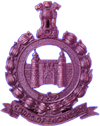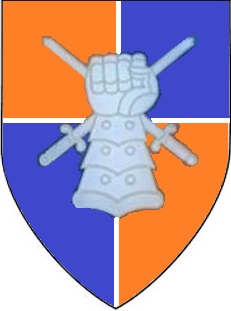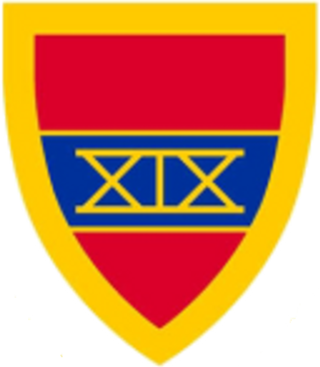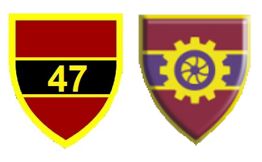
The South African Army is the principal land warfare force of South Africa, a part of the South African National Defence Force (SANDF), along with the South African Air Force, South African Navy and South African Military Health Service. The Army is commanded by the Chief of the Army, who is subordinate to the Chief of the SANDF.

1 South African Tank Regiment is an armoured regiment of the South African Army, based at the Tempe military base in Bloemfontein as part of the South African Army Armour Formation.

The Canadian Military Engineers is the military engineering personnel branch of the Canadian Armed Forces. The members of the branch that wear army uniform comprise the Corps of Royal Canadian Engineers.

The South African Army Artillery Formation is the controlling entity of all South African Army artillery units. It draws much of its history from the South African Artillery, established in 1934 but with roots that reach back to 1921. The formation consists of both regular and reserve units. There is a separate South African Army Air Defence Artillery Formation that directs army anti-aircraft warfare units.

The Royal Australian Engineers (RAE) is the military engineering corps of the Australian Army. The RAE is ranked fourth in seniority of the corps of the Australian Army, behind the Staff Cadets, Armoured and Artillery Corps. The corps was formed by the amalgamation of the various colonial engineer corps of the states and territories of Australia in 1902 and since then has served in various conflicts including World War I, World War II and the Vietnam War. The corps has also served on numerous peacekeeping operations and was heavily involved in the Australian contribution to the war in Afghanistan.

The Indian Army Corps of Engineers is a combat support arm which provides combat engineering support, develops infrastructure for armed forces and other defence organisations and maintains connectivity along the borders, besides helping the civil authorities during natural disasters. College of Military Engineering, Pune (CME) is the premier technical and tactical training institution of the Indian Army Corps of Engineers.
The South African Army is divided into functional branches, known as corps. Most consist of units, but some, such as the SA Staff Corps, consist only of personnel who are assigned to headquarters and units. The following is a list of corps established since 1912.
The 2nd Combat Engineer Regiment (2 CER) is an Australian Army combat engineer regiment located at Gallipoli Barracks in Brisbane, Queensland. It is part of the Australian 7th Brigade, attached to Forces Command (Australia).

The South African Army Armour Formation provides an Armour capability to the South African Army. The Formation came into being as part of a restructure. South African Armour Corps units previously under the command of various different brigades and other formations were all grouped under one formation. All armour is assigned to the SA Army Armour Formation under the charge of a General Officer Commanding.

The Umkhonto Field Engineer Regiment is a regiment of the South African Army Engineer Formation. The unit is based in Durban with the HQ being at Old Fort Military Base, Lord's Grounds. As a reserve unit, it has a status roughly equivalent to that of a British Army Reserve or United States Army National Guard unit.

Orange Free State Command was a command of the South African Army, active from c. 1933 to c. 1999. Its headquarters was at Bloemfontein, seemingly for a period at the Tempe airfield, later to become the Tempe Military Base.

7 South African Infantry Division was a formation of the South African Army, active from the 1960s to 1999.
This page details the South African Army order of battle in 1940, before and after the formation of expeditionary forces.

The School of Engineers is part of the South African Army Engineer Formation, which provides combat engineering corps training and teaching to military officers and personnel as well as other Military Schools throughout the South African National Defence Force. They are currently the only Military School in Southern Africa to formally present IEDD.

2 Field Engineer Regiment SAEC is a regiment of the South African Engineer Corps. The unit is based in Bethlehem, Free State. The role of the unit is to maintain mobility and serviceability of own forces and counter mobility of enemy forces. Tasks include bridging, water purification, obstacles, demolition, infrastructure repair and development.

The Ihawu Field Engineer Regiment is a reserve engineer regiment of the South African Army.

The Engineer Terrain Intelligence Regiment is a regiment of the South African Army Engineer Formation. The unit is based in Pretoria, Gauteng. It is responsible for providing the cartography needs of the South African Army.

35 Engineer Support Regiment is a regiment of the South African Engineer Corps. The role of the unit is to be the depot of prime mission equipment for the engineer corps.

There are currently 9 main military bands currently belonging to the South African National Defence Force (SANDF), which represent the different branches of the SANDF and providing music on ceremonial occasions. Since military bands were introduced in the country, they have played a prominent role in public and military life. Pipe bands also play an important role in South African military music, with notable pipe bands coming from the Cape Town Highlanders, Transvaal Scottish Regiment and the South African Military Health Service. Military bands of the SANDF are also affiliated with the police bands of the South African Police Service. In addition to military music, military bands in the SANDF perform different genres, including classical, jazz, pop and light music.








































